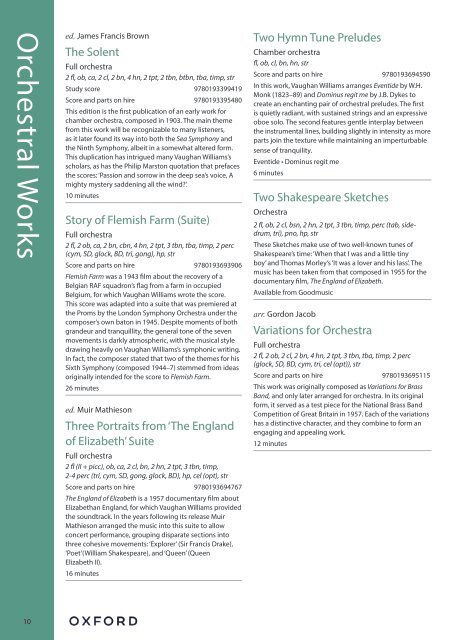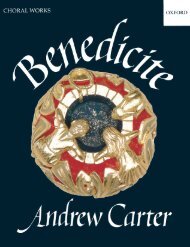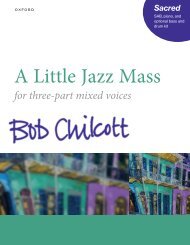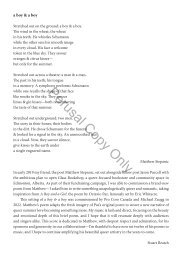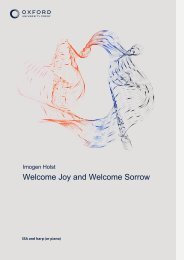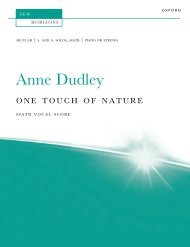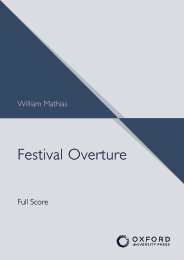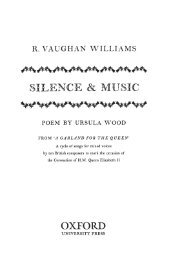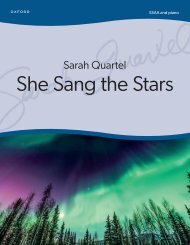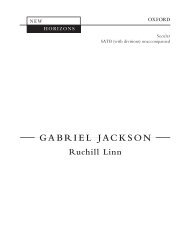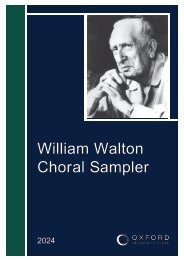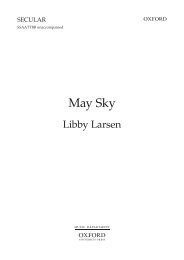Ralph Vaughan Williams Catalogue
Discover the music of Ralph Vaughan Williams published by OUP. ‘No one composer can fully cater to all one's moods...but Vaughan Williams's music comes closest to being the perfect companion on that mythical desert island.’ Alain Frogley, BBC Music Magazine
Discover the music of Ralph Vaughan Williams published by OUP.
‘No one composer can fully cater to all one's moods...but Vaughan Williams's music comes closest to being the perfect companion on that mythical desert island.’
Alain Frogley, BBC Music Magazine
Create successful ePaper yourself
Turn your PDF publications into a flip-book with our unique Google optimized e-Paper software.
Orchestral Works<br />
ed. James Francis Brown<br />
The Solent<br />
Full orchestra<br />
2 fl, ob, ca, 2 cl, 2 bn, 4 hn, 2 tpt, 2 tbn, btbn, tba, timp, str<br />
Study score 9780193399419<br />
Score and parts on hire 9780193395480<br />
This edition is the first publication of an early work for<br />
chamber orchestra, composed in 1903. The main theme<br />
from this work will be recognizable to many listeners,<br />
as it later found its way into both the Sea Symphony and<br />
the Ninth Symphony, albeit in a somewhat altered form.<br />
This duplication has intrigued many <strong>Vaughan</strong> <strong>Williams</strong>’s<br />
scholars, as has the Philip Marston quotation that prefaces<br />
the scores: ‘Passion and sorrow in the deep sea’s voice, A<br />
mighty mystery saddening all the wind?’.<br />
10 minutes<br />
Story of Flemish Farm (Suite)<br />
Full orchestra<br />
2 fl, 2 ob, ca, 2 bn, cbn, 4 hn, 2 tpt, 3 tbn, tba, timp, 2 perc<br />
(cym, SD, glock, BD, tri, gong), hp, str<br />
Score and parts on hire 9780193693906<br />
Flemish Farm was a 1943 film about the recovery of a<br />
Belgian RAF squadron’s flag from a farm in occupied<br />
Belgium, for which <strong>Vaughan</strong> <strong>Williams</strong> wrote the score.<br />
This score was adapted into a suite that was premiered at<br />
the Proms by the London Symphony Orchestra under the<br />
composer’s own baton in 1945. Despite moments of both<br />
grandeur and tranquillity, the general tone of the seven<br />
movements is darkly atmospheric, with the musical style<br />
drawing heavily on <strong>Vaughan</strong> <strong>Williams</strong>’s symphonic writing.<br />
In fact, the composer stated that two of the themes for his<br />
Sixth Symphony (composed 1944–7) stemmed from ideas<br />
originally intended for the score to Flemish Farm.<br />
26 minutes<br />
ed. Muir Mathieson<br />
Three Portraits from ‘The England<br />
of Elizabeth’ Suite<br />
Full orchestra<br />
2 fl (II + picc), ob, ca, 2 cl, bn, 2 hn, 2 tpt, 3 tbn, timp,<br />
2-4 perc (tri, cym, SD, gong, glock, BD), hp, cel (opt), str<br />
Score and parts on hire 9780193694767<br />
The England of Elizabeth is a 1957 documentary film about<br />
Elizabethan England, for which <strong>Vaughan</strong> <strong>Williams</strong> provided<br />
the soundtrack. In the years following its release Muir<br />
Mathieson arranged the music into this suite to allow<br />
concert performance, grouping disparate sections into<br />
three cohesive movements: ‘Explorer’ (Sir Francis Drake),<br />
‘Poet’(William Shakespeare), and ‘Queen’ (Queen<br />
Elizabeth II).<br />
Two Hymn Tune Preludes<br />
Chamber orchestra<br />
fl, ob, cl, bn, hn, str<br />
Score and parts on hire 9780193694590<br />
In this work, <strong>Vaughan</strong> <strong>Williams</strong> arranges Eventide by W.H.<br />
Monk (1823–89) and Dominus regit me by J.B. Dykes to<br />
create an enchanting pair of orchestral preludes. The first<br />
is quietly radiant, with sustained strings and an expressive<br />
oboe solo. The second features gentle interplay between<br />
the instrumental lines, building slightly in intensity as more<br />
parts join the texture while maintaining an imperturbable<br />
sense of tranquility.<br />
Eventide • Dominus regit me<br />
6 minutes<br />
Two Shakespeare Sketches<br />
Orchestra<br />
2 fl, ob, 2 cl, bsn, 2 hn, 2 tpt, 3 tbn, timp, perc (tab, sidedrum,<br />
tri), pno, hp, str<br />
These Sketches make use of two well-known tunes of<br />
Shakespeare’s time: ‘When that I was and a little tiny<br />
boy’ and Thomas Morley’s ‘It was a lover and his lass’. The<br />
music has been taken from that composed in 1955 for the<br />
documentary film, The England of Elizabeth.<br />
Available from Goodmusic<br />
arr. Gordon Jacob<br />
Variations for Orchestra<br />
Full orchestra<br />
2 fl, 2 ob, 2 cl, 2 bn, 4 hn, 2 tpt, 3 tbn, tba, timp, 2 perc<br />
(glock, SD, BD, cym, tri, cel (opt)), str<br />
Score and parts on hire 9780193695115<br />
This work was originally composed as Variations for Brass<br />
Band, and only later arranged for orchestra. In its original<br />
form, it served as a test piece for the National Brass Band<br />
Competition of Great Britain in 1957. Each of the variations<br />
has a distinctive character, and they combine to form an<br />
engaging and appealing work.<br />
12 minutes<br />
ed. David Matthews<br />
Concerto for Bass Tuba and<br />
Orchestra<br />
Solo tuba and orchestra<br />
tba solo, 2 fl, ob, 2 cl, bn, 2 hn, 2 tpt, 2 tbn, timp, 2 perc (SD,<br />
cym, tri, BD), str<br />
Study score 9780193386754<br />
Score and parts on hire 9780193694569<br />
Arrangement for tuba and piano 9780193386761<br />
Full score* 9780193694545<br />
The Concerto for bass tuba and orchestra was composed<br />
1953–4 to mark the 50th anniversary of the formation of<br />
the London Symphony Orchestra and was written for the<br />
orchestra’s principal tuba player, Philip Catelinet. It was the<br />
first major concerto to be written for the instrument, and<br />
remains today the outstanding work of its kind.<br />
*Available from Emerson Wind Music<br />
13 minutes<br />
arr. David Childs and Rodney Newton<br />
Concerto for Tenor Tuba<br />
Solo Tenor Tuba (Euphonium) and Orchestra<br />
Tenor Tba solo, Fl 1&2, Ob, Clar 1&2, Bsn, Hn 1&2, Tpt 1&2,<br />
Trbn, Timp, Perc, Solo Eup, Str.<br />
Score and parts on hire 9780193543737<br />
Arrangement for tenor tuba and piano Publishing 2022<br />
<strong>Vaughan</strong> <strong>Williams</strong>’s Concerto for Bass Tuba and Orchestra<br />
was the first major concerto to be written for the<br />
instrument. It was composed in 1953–4 to mark the<br />
50th anniversary of the LSO, and was premiered by the<br />
orchestra’s principal tuba player, Philip Catelinet. The<br />
original plan to transpose it for Euphonium was not<br />
realised during the composer’s lifetime, and only now,<br />
in this transcription by David Childs, has that goal been<br />
attained, with <strong>Vaughan</strong> <strong>Williams</strong>’s orchestration deftly<br />
transposed and rearranged by Rodney Newton to allow<br />
this characteristic work to enter the repertoire of many<br />
more players.<br />
14 minutes<br />
Works for Solo & Orchestra<br />
Concerto for Oboe and Strings<br />
Solo oboe and string orchestra<br />
ob solo and str<br />
Score and parts on hire 9780193692329<br />
Oboe solo and piano reduction 9780193692312<br />
Study score* 9780193692305<br />
A capricious, lyrical, and nostalgic work, it is often<br />
considered to be <strong>Vaughan</strong> <strong>Williams</strong>’s most successful work<br />
in this form. The first movement is pastoral in feeling. The<br />
second movement begins with a minuet, light and staccato<br />
in nature, with a middle section featuring a musette’s<br />
characteristic long-held drone played by the oboe with the<br />
melody in the strings. The third movement is a scherzo and<br />
two trios.<br />
*Available from Emerson Wind Music<br />
17 minutes<br />
Concerto for Violin<br />
Concerto Accademico<br />
Solo violin and string orchestra<br />
vln solo, str<br />
Score and parts on hire 9780193695238<br />
Arrangement for violin and piano* 9780193695221<br />
Concerto for Violin was composed 1924–5 at a time when<br />
neo-classicism was being explored by many of the leading<br />
composers of the day. It seamlessly combines references to<br />
the baroque style with <strong>Vaughan</strong> <strong>Williams</strong>’s own distinctive<br />
vein of pastoral violin writing, so beautifully demonstrated<br />
in the earlier The Lark Ascending. The work comprises three<br />
movements, each featuring contrasts in mood. The first<br />
movement juxtaposes heavy orchestral passages with<br />
elegant ones that bring the soloist to the fore. The central<br />
slow movement blends tranquil pastoralism with more<br />
sombre moments, while the Presto sets nimble melodies<br />
alongside jagged ones in a virtuosic close to the work.<br />
*Available from Emerson Wind Music<br />
16 minutes<br />
Works for Solo & Orchestra<br />
16 minutes<br />
10<br />
11


